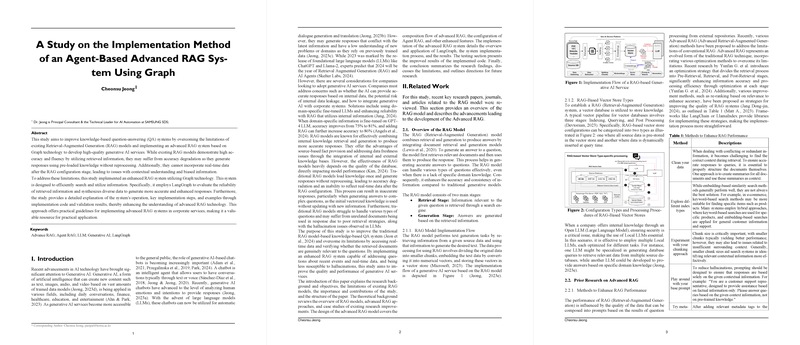Insights into the Implementation of an Agent-Based Advanced RAG System Using Graph Technology
The paper presented by Cheonsu Jeong explores the intricacies of advancing Retrival-Augmented Generation (RAG) models using graph technology. Traditional RAG systems, while proficient in integrating retrived information for generative AI tasks, often face limitations in maintaining up-to-date accuracy and contextual relevance post-configuration. This research proposes a novel agility in RAG systems by introducing graph-based enhancements that significantly amplify retrieval accuracy, especially pertinent in real-time knowledge-intensive environments.
The core proposition of this paper lies in the integration of LangGraph within advanced RAG architectures. LangGraph serves as a pivotal module for constructing workflows that effectively manage state transitions in agent networks. By deploying this graph-based methodology, Jeong seeks to address inherent weaknesses in conventional RAG systems, such as their dependency on static, pre-established knowledge bases that degrade in accuracy over time.
Key Components and Methodology
Jeong introduces an advanced RAG operational structure that incorporates several novel components:
- Query Processing: This initial step involves sophisticated recognition of user queries to ensure precise information retrieval.
- Graph-Based Workflow Management: Through LangGraph, complex workflows are managed, allowing for precise state-based transitions and branching logic.
- Agent-Driven Enhancements: The inclusion of distinct agent functionalities such as Self-RAG, Corrective RAG, and Adaptive RAG is crucial. These components are orchestrated to iteratively refine and verify generated responses against real-time data and contextual relevance.
The research underscores the importance of real-time data accessibility and adaptive learning capabilities to improve response generation. By transforming the RAG model with graph technologies, the paper demonstrates significant improvements in aligning generated text with dynamic and evolving databases, a feature traditionally lagging in older RAG models.
Implementation and Results
The research provides comprehensive testing and validation of the proposed model. Using LangGraph, real-time operations like document retrieval, information extraction, and contextual analysis have shown marked improvements. The system's ability to manage question rewriting and active querying enhances not only the contextual relevance of the answers but also solidifies the underpinning mechanisms by which these answers are derived. Implementation tests were conducted in a Python development environment utilizing a combination of LangChain, ChromaVector databases, and OpenAI LLMs.
Upon testing, the system demonstrated robust performance, effectively managing workflow states and adopting strategies that minimize errors in AI-generated responses. The 'Agent RAG Graph' showed efficient handling of real-time queries and integrating them into the knowledge base, showing significant promise for application in corporate and real-time environments requiring dynamic information retrieval.
Implications and Future Directions
The advancements suggested in the paper point towards substantial improvements in service quality and AI systems’ adaptability to new information. By overcoming the static nature of traditional RAG systems, the proposed architecture positions itself as a promising framework for future AI applications that demand real-time interaction, such as dynamic customer support and nuanced information retrieval services.
On the practical front, corporate entities that rely heavily on generative AI applications stand to benefit from this enhanced RAG system, not only through improved data integrity and response accuracy but also through the potential for integration across diverse domains. The ability to contextualize information swiftly and reliably plays a critical role in the competitive landscape of AI-driven solutions.
Future research should focus on further refining the adaptability of these systems across broader domains and ensuring the seamless integration of diverse data types. Enhancing the generalizability of graph-based RAG systems can lead to broader applications, with reinforced mechanisms for handling a variety of real-time data more efficiently. As RAG technology continues to evolve, maintaining agility and precision will be the benchmarks against which progress will be measured.
